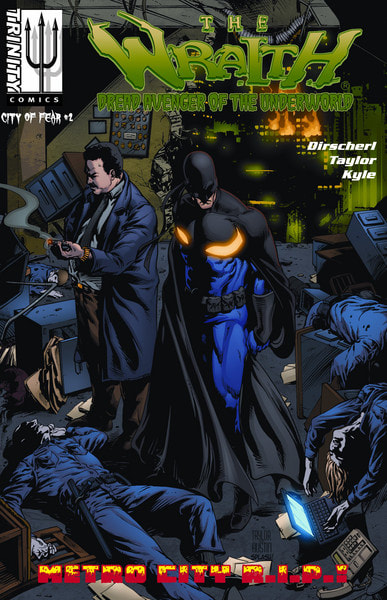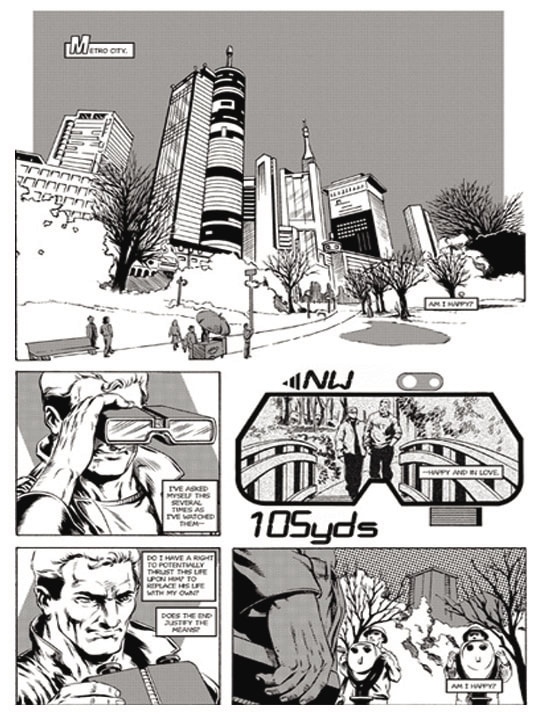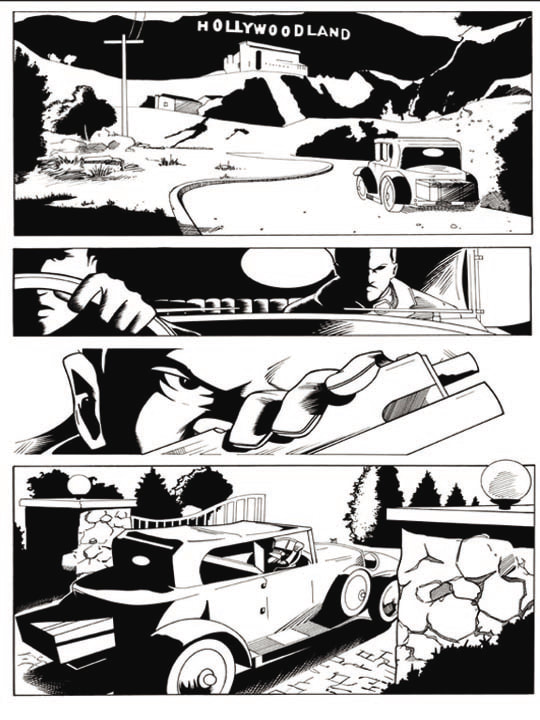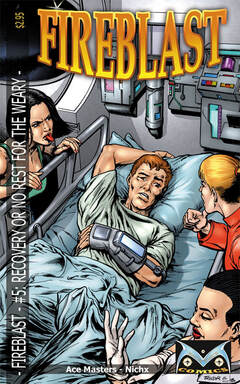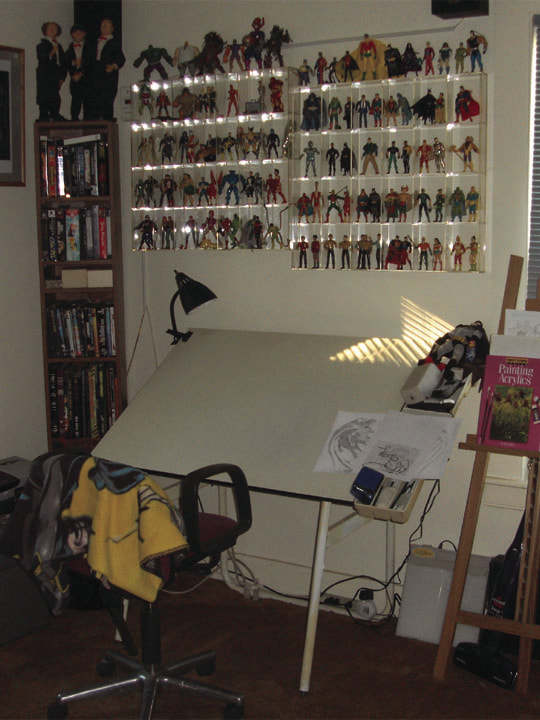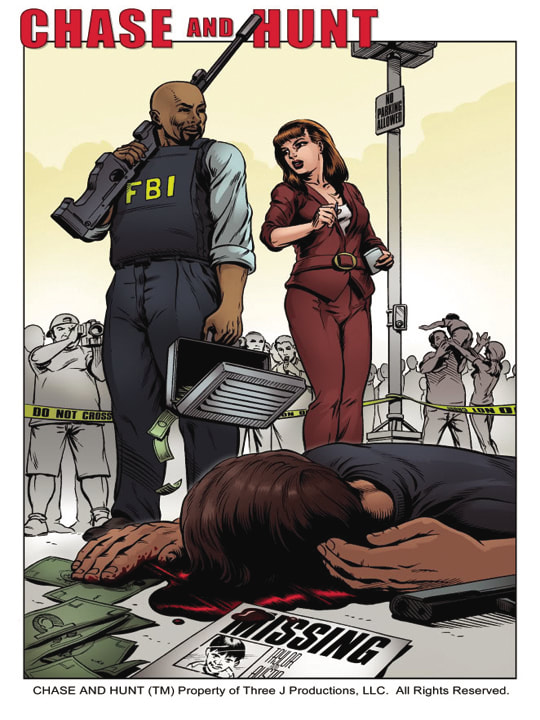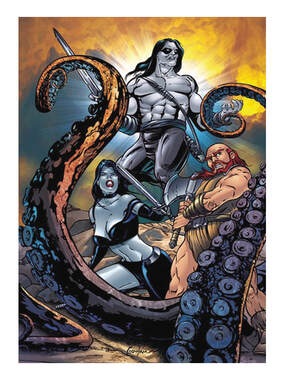Interview with...
|
JMH: Where were you born and raised?
JT: I was born in Springfield Ma, and grew up nearby in a town called Enfield CT. It's just north of the state capital of Hartford, about 15 minutes or so. Small town "bedroom" community when I was growing up there... but it's swelled it's ranks since then. Now I live in a small town, still nearby, called Broad Brook. Think of Mayberry... but with cable TV.
JMH: How long have you been drawing comics?
JT: I'm sure like a lot of comic folks; I started drawing my own "comics" when I was around 12 or 13 years old. I'd fold white math paper (the only "blank" paper available to me at the time) in half, and make my own mini comic. Sadly, none of those survived the great "I'm throwing this trash out" debacle of 1978. So in all, I'd have to say I've been drawing comics and comic related work for nearly 35 years now. Interesting side note. When I attended college, the one course I totally flunked, was Basic Art 101. The instructor was aghast that I would turn any assignment into a comic panel of some sort. From perspective drawings, to still life studies! Since then, I will occasionally send him a comic that I work on, or a commission I get, I'll send him an email with it attached... "Didn't get anywhere doing this did I?" is usually all I write.
JMH: How did you break into drawing comic books?
JT: I was in a shop getting my usual gathering of comics, and noticed some artwork on the wall of the store. i asked the owner who it belonged to, and he told me it was a fellow regular customer, Cesar Feliciano. I asked to have a meeting set up with him, and we eventually got together. We both shared of love of comics, and drawing, and decided to start attending conventions, bringing our work with us as we went. Eventually a small press publisher liked our work, especially when we teamed up together (with me on pencils, and Cesar on inks), and asked if we'd like to do a story he had in mind for print. That was the beginning, but by no means the last time we worked together on a book. From there it was a matter of networking, finding people that were looking for artist's, usually at no to little pay, but had good tales to tell. Working my way up the "newbie" ladder, I started to get noticed with my gallery of work online, and was contacted by those publishers as to my availability. It just sort of grew from there. The best tool any artist can have? The internet!
JMH: Have you drawn other characters or only your own properties?
JT: When I was younger (those mini comics I spoke about), they were all my own characters. And of course, they were all as cool as all get out (in my mind). Looking back, I've got one or two characters that I would really still like to do stories about, especially since I finally have half an idea of what I'm doing. I did work up one story with one of my own characters, but that book never saw the light of day. So I may still haul him out of the mothballs eventually, and work up something. Just have to find the right writer for the tale. I've drawn for other publishers, mostly small press, but still some great solid characters. Sometimes doing just a cover, sometimes the interior work. My biggest joy was being able to draw "The Wraith" (Trinity Comics), because the character is similar, without being a complete rip off, of my favorite character of all time. Which is of course, The Batman.
JMH: What sources do you use for a cover image?
JT: Usually I'll inquire of the writer what they were thinking of for a cover. I'll go back and read the entire story (even if I'm only doing the cover), and try to get that "moment" in the story that will really pop out for a cover. It's how they used to do it back in the 70's... with folks like Neal Adams, Dick Giordano, Curt Swan. They'd try to capture that one instant of time that would grab the reader from the spinner rack (man, am I showing my age), and say "Buy me, because this is a REALLY cool story". I rarely just sit down and put together a cover without researching, and discussing it with the person/publisher I'm working for. After that, my biggest source, is the internet. Not so much for design, but for technical aspects. I was instructed a long time ago by some very good art friends (and great artists in their own right)... the mantra of all artists (or it should be). Reference, reference, reference. Don't try to "fake it". If the cover calls for a dragon... look them up. See what other artists have done, which does not imply that you copy them, but man, you can get a lot of inspiration, as well as save a bunch of time, checking out what others have done.
JMH: How do you focus when drawing?
JT: I tend to do the majority of my art time late late late at night. No phone calls for distractions, and it also let's the wife get some sleep (ha)... So I just go into my studio with an enormous mug of coffee, crank up my ancient G3 Mac, bring up ITunes, and hit "play all", random and repeat of course. In about ten minutes, I'm so deep into the drawing; I just keep going until I notice the sun coming up.
JMH: What other mediums or genres have you drawn for?
JT: I'll admit, I have a preference for Superhero work, I just like the dynamics of it. But I've done Horror, a couple of illustrations for children's books, instructional manuals. Just about anything that will pay the bills really. I usually stick to pencils... but if the demand is there (and time is short)... I'll ink as well. But as I always tell the person inquiring "I can ink... but it ain't pretty." I prefer to let those that can ink, do their magic on my pencils. I've met some really good solid inkers in my time doing comics, but I have to say I think my favorite is Jeff Austin. We just seem to collaborate well together. When we're finished with an image, it's usually even better then I had originally planned!
JMH: What art training do you have?
JT: Mostly I'm self taught. And by that I mean, I'm still learning to this day! I did take the usual art classes in high school (and my abysmal art class in college), and even took private lessons for a brief time, trying to learn new techniques in painting. It's at those private classes, that I learned I was color blind, and so there went that aspiration (painting). I did enjoy doing sculpture work in high school. I found it helped me to better understand drawing in regards to trying to give a "full shape" and understand form better. These days, when I'm working on something, if it doesn't look right to me, I'll consult with my art buddies, and usually they can help pointing out where I may have gone off track, or something different that I could try. Develop those contacts, they're almost as invaluable as your own reference file!
JMH: What types of technology do you use to draw?
JT: Other then the computer for my music and scanning in images, the only tech I use is my 4H pencils, eraser, and a T square. Sometimes I'll even break out the templates for some things (circles etc)... but other then that, I'm fairly low tech in what I use. But for scanning, I use my Mustek scanner (love it) and my MacBook Pro (for scanning, and reference searches, print outs). It's made things a LOT easier.
JMH: If you could draw another company’s character which one would it be and why?
JT: Not even a challenge there. The Batman. Pure and simple. Surprisingly enough, I went to the DC offices once to show them my work, and see what I could get... the person I spoke to said that my work reminded him of Marshall Rogers. Which was a huge compliment. But then he said something else that has stuck with me. "If we want that look, we'll just get Marshall..." (this was quite a few years ago)... and it made me realize, that I had to try my best to develop my own unique style, so that it wasn't always "it looks like..." or "you're similar to..". They were still very nice at DC, and they gave me a script to take home and work on. Which I did (got a very nice letter from them too... but as far as I know, it's never been used... but I'm always hopeful!), and for me, it was a dream come true! I didn't exactly expect them to fall over themselves and say "We've FOUND the guy!"... but for them to even seriously look at my work and say it was good... just "not there" yet. Was like a big feather for my cap. Made the whole trip to NYC well worth it!
JMH: For anyone who wants to be an artist, what can you tell them about the craft?
JT: As I stated earlier. Reference. It's SO important. With the internet, you've got the biggest library the world has ever seen in regards to finding reference for just about anything. Don't neglect it. Study other artists, but don't just study in one area... check out people outside of comics. I love Norman Rockwell art, and can appreciate the "masters" of the Renaissance of course. These are obviously not comics folks, but their work can still inspire me. Draw as much as you can, even if it seems like it's totally boring "stuff". Go to the park with a sketch pad, and try to draw what you see. The pedestrians, the birds, the statues, the benches.... anything you can. Always look around you, when you visit a new place, check out the architecture, if you go into a basement, look how the pipes and electrical lines run. Sketch them if you can, but mostly try to capture them in your mind (or better yet, on a camera). This all seems mundane, but the next time you go to draw your favorite character in a certain setting, you'll be able to pull this stuff up, and make that sketch or cover or panel, even better because you've researched/seen it.
I can't remember who told this to me, but they said "Every artist has about 50,000 bad drawings in them until they start to get good." I'm probably at 37,489... so I've got a ways to go. But I'm still developing my skills, working on my technique, tweaking my approach to how and what I produce. I think it's a never ending process really. And most important, if you really want to grow as an artist,... don't have your family and friends look at your work for critiques. They all like and love you, and they don't want to hurt your feelings... even if your drawing of Spiderman does look more like the Michelin man. So they're going to say "that's great, you're awesome". Instead, find artists at conventions or online, that you really like THEIR work, and ask if they'll look at your stuff. Just be ready,... if they're honest with you, it's probably going to hurt at first. "What do you mean I can't draw hands!! I spent two hours on those!".... Don't take it personally. They are NOT commenting on you as a person, just on your work. Take their words, and advice, and use them the next time you sit down to draw. Remember what they said, and try to improve those points on your next project. It can only help. Being an artist is a journey, and one that you (and I) can never fully travel without some bumps along the way!
JMH: Tell us about your mini-comics...
JT: I've done various projects for many publishers... including "The Captains Jolting Tales" (One Shot Press), "Lovely as a Lie" (Illustration Studios), "The Wraith" (Trinity Press), "Fireblast" (Ace Masters Comics), and promotional artwork and covers for more comics then I can remember. I've yet to publish anything of my own (my own characters)... but I did do up one story of one of my own characters, but it's yet to see print. I may just go back and redraw it, and try to publish it through someone.
JMH: What are the names of your characters? What are their powers?
JT: Well, in the one story I referred to above, his name is Ian Ford... a bounty hunter, privateer, adventurer, body guard for hire,... set in the near future. The world has just come out of a major atomic scare, and things are topsy turvy. Ian has no special powers per se. He was a cop before the whole nuclear mess, and has a penchant for using older weapons (he usually carries a Luger pistol), and scotch. He has no allegiance to anyone but the payment he gets for his services. He does have a sense of morality though, and if he thinks you're not on the up and up, he won't take your job on... no matter how much you offer him.
JMH: Who are your artistic influences?
JT: I've got tons of artistic influences, both in and out of the comic medium. I'm partial to Neal Adams, John Buscema, Jose Louis Garcia-Lopez, Curt Swan, Marshall Rogers, Alex Toth, Alex Ross... as well as lesser known talents that I've worked with myself, such as Simon Williams, Shannon Gallant, Cesar Feliciano and Jeff Austin. I also like artists outside of the comics community like Norman Rockwell, Leonardo (and I don't mean the turtle), Rafael. They all have something to teach any artist.
JMH: Do you read any of the new comic books that are being published today?
JT: I'm still a diehard Batman fan, and read that and JSA as much as I can (I'm a dedicated DC man). Funny thing is... once you're in the "business" of producing comics, it's really difficult to attribute much time to reading them as you used to! It's not that I don't like what's out there... some of the work is incredible. I just don't find I have the time for it anymore. You're so busy getting your own stuff done... there's just no time!
JMH: What future projects do you have in works?
JT: Why, are you hiring? Just kidding. I've got a couple of projects that I'm obliged to keep hush about, but I've also got some things that should be coming out quite soon. Keep your eyes peeled! I think you're gonna like what ya see! I got to work with some of the writing pros of the comic industry that I've admired for years! That was really an honor and a challenge. On the whole, they've been encouraging, and helpful in developing my work.
JMH: Jim, Great interview!
JT: Thank you.
Discovery Jim Taylor's comics here:
www.drivethrucomics.com/product/116608/Sky-Watcher-1a
JT: I was born in Springfield Ma, and grew up nearby in a town called Enfield CT. It's just north of the state capital of Hartford, about 15 minutes or so. Small town "bedroom" community when I was growing up there... but it's swelled it's ranks since then. Now I live in a small town, still nearby, called Broad Brook. Think of Mayberry... but with cable TV.
JMH: How long have you been drawing comics?
JT: I'm sure like a lot of comic folks; I started drawing my own "comics" when I was around 12 or 13 years old. I'd fold white math paper (the only "blank" paper available to me at the time) in half, and make my own mini comic. Sadly, none of those survived the great "I'm throwing this trash out" debacle of 1978. So in all, I'd have to say I've been drawing comics and comic related work for nearly 35 years now. Interesting side note. When I attended college, the one course I totally flunked, was Basic Art 101. The instructor was aghast that I would turn any assignment into a comic panel of some sort. From perspective drawings, to still life studies! Since then, I will occasionally send him a comic that I work on, or a commission I get, I'll send him an email with it attached... "Didn't get anywhere doing this did I?" is usually all I write.
JMH: How did you break into drawing comic books?
JT: I was in a shop getting my usual gathering of comics, and noticed some artwork on the wall of the store. i asked the owner who it belonged to, and he told me it was a fellow regular customer, Cesar Feliciano. I asked to have a meeting set up with him, and we eventually got together. We both shared of love of comics, and drawing, and decided to start attending conventions, bringing our work with us as we went. Eventually a small press publisher liked our work, especially when we teamed up together (with me on pencils, and Cesar on inks), and asked if we'd like to do a story he had in mind for print. That was the beginning, but by no means the last time we worked together on a book. From there it was a matter of networking, finding people that were looking for artist's, usually at no to little pay, but had good tales to tell. Working my way up the "newbie" ladder, I started to get noticed with my gallery of work online, and was contacted by those publishers as to my availability. It just sort of grew from there. The best tool any artist can have? The internet!
JMH: Have you drawn other characters or only your own properties?
JT: When I was younger (those mini comics I spoke about), they were all my own characters. And of course, they were all as cool as all get out (in my mind). Looking back, I've got one or two characters that I would really still like to do stories about, especially since I finally have half an idea of what I'm doing. I did work up one story with one of my own characters, but that book never saw the light of day. So I may still haul him out of the mothballs eventually, and work up something. Just have to find the right writer for the tale. I've drawn for other publishers, mostly small press, but still some great solid characters. Sometimes doing just a cover, sometimes the interior work. My biggest joy was being able to draw "The Wraith" (Trinity Comics), because the character is similar, without being a complete rip off, of my favorite character of all time. Which is of course, The Batman.
JMH: What sources do you use for a cover image?
JT: Usually I'll inquire of the writer what they were thinking of for a cover. I'll go back and read the entire story (even if I'm only doing the cover), and try to get that "moment" in the story that will really pop out for a cover. It's how they used to do it back in the 70's... with folks like Neal Adams, Dick Giordano, Curt Swan. They'd try to capture that one instant of time that would grab the reader from the spinner rack (man, am I showing my age), and say "Buy me, because this is a REALLY cool story". I rarely just sit down and put together a cover without researching, and discussing it with the person/publisher I'm working for. After that, my biggest source, is the internet. Not so much for design, but for technical aspects. I was instructed a long time ago by some very good art friends (and great artists in their own right)... the mantra of all artists (or it should be). Reference, reference, reference. Don't try to "fake it". If the cover calls for a dragon... look them up. See what other artists have done, which does not imply that you copy them, but man, you can get a lot of inspiration, as well as save a bunch of time, checking out what others have done.
JMH: How do you focus when drawing?
JT: I tend to do the majority of my art time late late late at night. No phone calls for distractions, and it also let's the wife get some sleep (ha)... So I just go into my studio with an enormous mug of coffee, crank up my ancient G3 Mac, bring up ITunes, and hit "play all", random and repeat of course. In about ten minutes, I'm so deep into the drawing; I just keep going until I notice the sun coming up.
JMH: What other mediums or genres have you drawn for?
JT: I'll admit, I have a preference for Superhero work, I just like the dynamics of it. But I've done Horror, a couple of illustrations for children's books, instructional manuals. Just about anything that will pay the bills really. I usually stick to pencils... but if the demand is there (and time is short)... I'll ink as well. But as I always tell the person inquiring "I can ink... but it ain't pretty." I prefer to let those that can ink, do their magic on my pencils. I've met some really good solid inkers in my time doing comics, but I have to say I think my favorite is Jeff Austin. We just seem to collaborate well together. When we're finished with an image, it's usually even better then I had originally planned!
JMH: What art training do you have?
JT: Mostly I'm self taught. And by that I mean, I'm still learning to this day! I did take the usual art classes in high school (and my abysmal art class in college), and even took private lessons for a brief time, trying to learn new techniques in painting. It's at those private classes, that I learned I was color blind, and so there went that aspiration (painting). I did enjoy doing sculpture work in high school. I found it helped me to better understand drawing in regards to trying to give a "full shape" and understand form better. These days, when I'm working on something, if it doesn't look right to me, I'll consult with my art buddies, and usually they can help pointing out where I may have gone off track, or something different that I could try. Develop those contacts, they're almost as invaluable as your own reference file!
JMH: What types of technology do you use to draw?
JT: Other then the computer for my music and scanning in images, the only tech I use is my 4H pencils, eraser, and a T square. Sometimes I'll even break out the templates for some things (circles etc)... but other then that, I'm fairly low tech in what I use. But for scanning, I use my Mustek scanner (love it) and my MacBook Pro (for scanning, and reference searches, print outs). It's made things a LOT easier.
JMH: If you could draw another company’s character which one would it be and why?
JT: Not even a challenge there. The Batman. Pure and simple. Surprisingly enough, I went to the DC offices once to show them my work, and see what I could get... the person I spoke to said that my work reminded him of Marshall Rogers. Which was a huge compliment. But then he said something else that has stuck with me. "If we want that look, we'll just get Marshall..." (this was quite a few years ago)... and it made me realize, that I had to try my best to develop my own unique style, so that it wasn't always "it looks like..." or "you're similar to..". They were still very nice at DC, and they gave me a script to take home and work on. Which I did (got a very nice letter from them too... but as far as I know, it's never been used... but I'm always hopeful!), and for me, it was a dream come true! I didn't exactly expect them to fall over themselves and say "We've FOUND the guy!"... but for them to even seriously look at my work and say it was good... just "not there" yet. Was like a big feather for my cap. Made the whole trip to NYC well worth it!
JMH: For anyone who wants to be an artist, what can you tell them about the craft?
JT: As I stated earlier. Reference. It's SO important. With the internet, you've got the biggest library the world has ever seen in regards to finding reference for just about anything. Don't neglect it. Study other artists, but don't just study in one area... check out people outside of comics. I love Norman Rockwell art, and can appreciate the "masters" of the Renaissance of course. These are obviously not comics folks, but their work can still inspire me. Draw as much as you can, even if it seems like it's totally boring "stuff". Go to the park with a sketch pad, and try to draw what you see. The pedestrians, the birds, the statues, the benches.... anything you can. Always look around you, when you visit a new place, check out the architecture, if you go into a basement, look how the pipes and electrical lines run. Sketch them if you can, but mostly try to capture them in your mind (or better yet, on a camera). This all seems mundane, but the next time you go to draw your favorite character in a certain setting, you'll be able to pull this stuff up, and make that sketch or cover or panel, even better because you've researched/seen it.
I can't remember who told this to me, but they said "Every artist has about 50,000 bad drawings in them until they start to get good." I'm probably at 37,489... so I've got a ways to go. But I'm still developing my skills, working on my technique, tweaking my approach to how and what I produce. I think it's a never ending process really. And most important, if you really want to grow as an artist,... don't have your family and friends look at your work for critiques. They all like and love you, and they don't want to hurt your feelings... even if your drawing of Spiderman does look more like the Michelin man. So they're going to say "that's great, you're awesome". Instead, find artists at conventions or online, that you really like THEIR work, and ask if they'll look at your stuff. Just be ready,... if they're honest with you, it's probably going to hurt at first. "What do you mean I can't draw hands!! I spent two hours on those!".... Don't take it personally. They are NOT commenting on you as a person, just on your work. Take their words, and advice, and use them the next time you sit down to draw. Remember what they said, and try to improve those points on your next project. It can only help. Being an artist is a journey, and one that you (and I) can never fully travel without some bumps along the way!
JMH: Tell us about your mini-comics...
JT: I've done various projects for many publishers... including "The Captains Jolting Tales" (One Shot Press), "Lovely as a Lie" (Illustration Studios), "The Wraith" (Trinity Press), "Fireblast" (Ace Masters Comics), and promotional artwork and covers for more comics then I can remember. I've yet to publish anything of my own (my own characters)... but I did do up one story of one of my own characters, but it's yet to see print. I may just go back and redraw it, and try to publish it through someone.
JMH: What are the names of your characters? What are their powers?
JT: Well, in the one story I referred to above, his name is Ian Ford... a bounty hunter, privateer, adventurer, body guard for hire,... set in the near future. The world has just come out of a major atomic scare, and things are topsy turvy. Ian has no special powers per se. He was a cop before the whole nuclear mess, and has a penchant for using older weapons (he usually carries a Luger pistol), and scotch. He has no allegiance to anyone but the payment he gets for his services. He does have a sense of morality though, and if he thinks you're not on the up and up, he won't take your job on... no matter how much you offer him.
JMH: Who are your artistic influences?
JT: I've got tons of artistic influences, both in and out of the comic medium. I'm partial to Neal Adams, John Buscema, Jose Louis Garcia-Lopez, Curt Swan, Marshall Rogers, Alex Toth, Alex Ross... as well as lesser known talents that I've worked with myself, such as Simon Williams, Shannon Gallant, Cesar Feliciano and Jeff Austin. I also like artists outside of the comics community like Norman Rockwell, Leonardo (and I don't mean the turtle), Rafael. They all have something to teach any artist.
JMH: Do you read any of the new comic books that are being published today?
JT: I'm still a diehard Batman fan, and read that and JSA as much as I can (I'm a dedicated DC man). Funny thing is... once you're in the "business" of producing comics, it's really difficult to attribute much time to reading them as you used to! It's not that I don't like what's out there... some of the work is incredible. I just don't find I have the time for it anymore. You're so busy getting your own stuff done... there's just no time!
JMH: What future projects do you have in works?
JT: Why, are you hiring? Just kidding. I've got a couple of projects that I'm obliged to keep hush about, but I've also got some things that should be coming out quite soon. Keep your eyes peeled! I think you're gonna like what ya see! I got to work with some of the writing pros of the comic industry that I've admired for years! That was really an honor and a challenge. On the whole, they've been encouraging, and helpful in developing my work.
JMH: Jim, Great interview!
JT: Thank you.
Discovery Jim Taylor's comics here:
www.drivethrucomics.com/product/116608/Sky-Watcher-1a
All interviews on this website © 2011-2022 Comicbookinterviews.com


